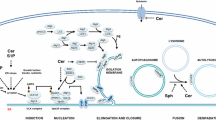Abstract
Sphingolipids are present in animals, plants, fungi, yeasts and some bacteria. In mammalian cells sphingolipids act as lipid mediators for cell growth, differentiation, apoptosis and angio-genesis. In contrast, in bacteria the biological significance of sphingolipids has not been fully elucidated and sphingolipid metabolism has not been investigated. The aim of this study was to compare the pattern of sphingolipid metabolites in HIT-T15 ß cells originating from hamster pancreas to that in the bacterial strainSphingomonas chungbukensis DJ77, under various culture conditions. It was found that the concentration of cellular sphinganine (Sa) in S.chungbukensis was higher than that of sphingosine (So), while the level of cellular So in HIT-T15 cells was higher than that of Sa. Aeration and shaking during culture increased bacterial growth in S.chungbukensis, and the contents of So and Sa were also elevated. These results indicate that a denovo sphingolipid pathway appeared to be active in bacteria and that bacterial growth may be closely related to Sa levels.
Similar content being viewed by others
References
Beeler, T., Gable, K., Zhao, C., and Dunn, T., A novel protein, CSG2p, is required for Ca2+ regulation inSaccharomyces cerevisiae.J. Biol. Chem., 269, 7279–7284 (1994).
Dickson, R. C. and Lester, R. L, Yeast sphingolipids.Biochim. Biophys. Acta., 1426, 347–357 (1999).
Dickson R. C, Nagiec E. E., Wells G. B., Nagiec M. M., and Lester R. L., Synthesis of mannose-(inositol-P)2-ceramide, the major sphingolipid inSaccharomyces cerevisiae, requires the IPT1 (YDR072c) gene.J. Biol. Chem., 272, 29620–29625 (1997).
Dickson, R. C., Sumanasekera, C, and Lester, R. L., Functions and metabolism of sphingolipids inSaccharomyces cerevisiae.Prog. Lipid Res., 45, 447–465 (2006).
Gaver, R. C. and Sweeley, C. C., Methods for methanolysis of sphingolipids and direct determination of long-chain bases by gas chromatography.J. Am. Oil Chem. Soc, 42, 294–298 (1965).
Grilley, M. M., Stock, S. D., Dickson, R. C., Lester, R. I., and Takemoto, J. Y, Syringomycin action geneSYR2 is essential for sphingolipid 4-hydroxylation inSaccharomyces cerevisiae.J. Biol. Chem., 273, 11062–11068 (1998).
Guillas, I., Kirchman, P. A., Chuard, R., Pfefferli, M., Jiang, J. C., Jazwinski, S. M., and Conzelmann A., C26-CoA-dependent ceramide synthesis ofSaccharomyces cerevisiae is operated by Lag 1p and lac 1p.J. EMBO, 20, 2655–2665 (2001).
Hakomori, S. and Igarashi, Y, Gangliosides and glycosphing- olipids as modulators of cell growth, adhesion, and trans-membrane signaling.Adv. Lipid Res., 25, 147–162 (1993).
Ikushiro, H., Hayashi, H., and Kagamiyama, H., Bacterial serine palmitoyltransferase: a water-soluble homodimeric prototype of the eukaryotic enzyme.Biochim. Biophys. Acta., 1647, 116–120 (2003).
Kawahara, K., Moll, H., Knirel, Y A., Seydel, U., and Zahringer, U., Structural analysis of two glycosphingolipids from the lipopolysaccharide-lacking bacteriumSphingomonas capsulata.Eur. J. Biochem., 267,1837–1846 (2000).
Kawasaki, S., Moriguchi, R., Sekiya, K., Nakai, T., Ono, E., Kume, K., and Kawahara, K., The cell envelope structure of the lipopolysaccharide-lacking gram-negative bacteriumSphingomonas paucimobilis.J. Bacteriol., 176, 284–290 (1994).
Kim, S. J., Chung, J. S., Bae, K. S., and Kim, Y C, Polyphasic assignment of an aromatic-degradingPseudomonas sp., strain DJ77, in the genusSphingomonas asSphingomonas chungbukensis sp. nov.Int. J. Syst. Evol. Microbiol., 50, 1641–1647 (2000).
Kim, C. K., Kim, J. W., Kim, Y C, and Mheen, T. I., Isolation of aromatic hydrocarbon-degrading bacteria and genetic characterization of their plasmid genes.Kor. J. Microbiol., 24, 67–72 (1986).
Min J. K., Yoo H. S., Lee E. Y, Lee W. J., and Lee Y. M., Simultaneous quantitative analysis of sphingoid base 1- phosphates in biological samples o-phthalaldehyde precolumn derivatization after dephosphorylation with alkaline Phosphatase.Anal. Biochem., 303, 167–175 (2002).
Naka, T., Fujiwara, N., Yano, I., Maeda, S., Doe, M., Minamino, M., Ikeda, N., Kato, Y, Watabe, K., Kumazawa,Y, Tomiyasu, I., and Kobayashi K., Structural analysis of sphingophos- pholipids derived fromSphingobactehum spiritivorum, the type species of genusSphingobactehum.Biochim. Biophys. Acta., 1635, 83–92 (2003).
Nichols, F. C, Novel ceramides recovered fromPorphyro-monas gingivalis: relationship to adult Periodontitis.J. Lipid Res., 39, 2360–2372 (1998).
White, D. C, Sutton, S. D., and Ringelberg, D. B., The genusSphingomonas: physiology and ecology.Cur. Opin. Biote- chnol, 7,301–306 (1996).
Yabuuchi, E., Yano, I., Oyaizu, H., Hashimoto, Y, Ezaki, T., and Yamamoto, H., Proposals ofSphingomonas paucimobilis gen. nov. and comb. nov.,Sphingomonas parapaucimobilis sp. nov.,Sphingomonas yanoikuyae sp. nov,Sphingomonas adhaesiva sp. nov.,Sphingomonas capsulata comb, nov., and two genospecies of the genusSphingomonas.Microbiol. Immunol., 34, 99–119 (1990).
Author information
Authors and Affiliations
Corresponding author
Rights and permissions
About this article
Cite this article
Burenjargal, M., Lee, YS., Yoo, JM. et al. Endogenous sphingolipid metabolites related to the growth inSphingomonas chungbukensis . Arch Pharm Res 30, 317–322 (2007). https://doi.org/10.1007/BF02977612
Received:
Issue Date:
DOI: https://doi.org/10.1007/BF02977612




